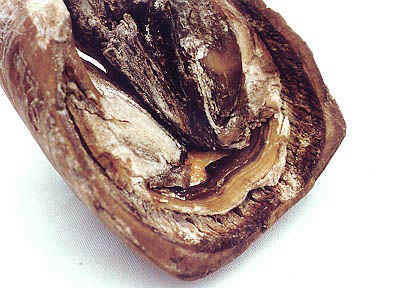
Treating Founder (Chronic Laminitis) without Horseshoes, Section 8
(Version with full-sized photos)
Sole Penetration
When founder gets advanced, you can have the coffin bone actually slicing through the sole:

Sole Penetration.
(Specimen courtesy of David Frederick, DVM)
(The above mare's owner was treating her for what he thought was arthritis, giving 4 butes a day, for several months. He was "killing her with kindness," giving her as much rich alfalfa hay as she wanted, and lots of grain. All this overeating of rich feed was the trigger for her foundering, and would have had to be stopped before the bute could have had much effect controlling her condition. Her founder was unrecognized for several months, until her owner finally called Dr. Frederick in for a second opinion. The mare's toes were also too long, adding leverage to the problem. High, contracted heels resulting in less circulation, make such horses more vulnerable to various laminitis triggers like carbohydrate overload. Dr. Frederick squared the toes to ease her breakover. It was too little, too late. Sabine tells me that the heels were not lowered enough.)
Sabine tells me that bute actually can reduce circulation because it is an anti-inflammatory; inflammation is the product of increased circulation.
What CAUSES Sole penetration?
A coffin bone is rather sharp-edged. When the coffin bone is tilted, instead of the bottom of the bone being ground-parallel, the toe of the coffin bone is crushing the sole corium (blood supply to the sole). The result is that new sole cannot grow. As old sole is worn away, it is not replaced with new sole, resulting in the sole getting thinner and thinner until you get actual sole penetration.
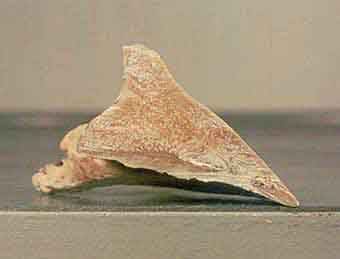
Showing how sharp the tip of the coffin bone is.
Dissection below showing the delicate layer of corium that is being crushed by the coffin bone. This soft layer of blood vessels cannot feed the growth of new sole when it is being crushed by the sharp tip of the coffin bone.:
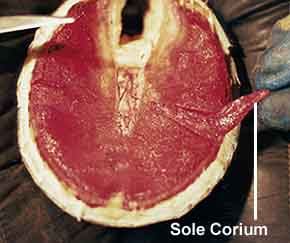
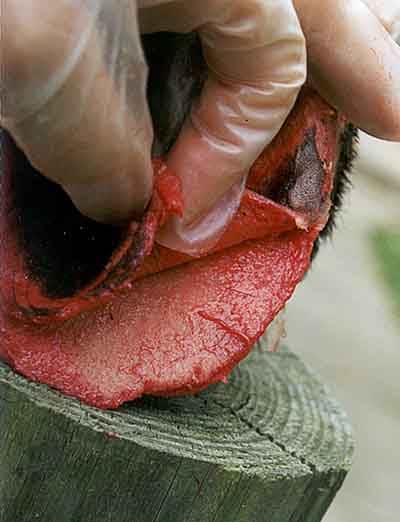
Sole Penetration is not fatal:
It is possible to nurse a horse through a sole penetration, but he will be in a lot of pain for a while. Dr. Strasser has been able to reverse it in 6-8 weeks, however. Needed: clean, non-concussive ground, such as the huge area in her clinic covered with rubber mats. And lots of movement and daily soaks in apple cider vinegar solution. There are number of horses milling around in the clinic; they motivate each other to keep moving, and keep each other's morale up by having a social life. You need to use removable hoof boots for exercising them on hard, rocky ground. Getting the correct hairline slope is really important to speeding up the process. She sometimes uses propolis tincture on open wounds as well.
Al Catalfumo has a gelding who recovered from sole penetration on all four feet. The fronts were rotated "halfway" when the Equine Digit Support System shoeing was put on. Eight weeks later, when the shoes were removed, he had additional rotation and sole penetration. The hinds, which were also rotated at the time the shoes were put on, were left barefoot. The hinds rotated more, too, and had sole penetration, but fared better because abscesses were able to drain out the sole instead of being forced out the coronet band. His photos show rapid progress in 6 weeks:
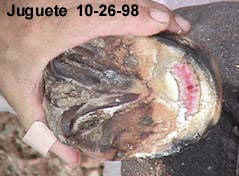
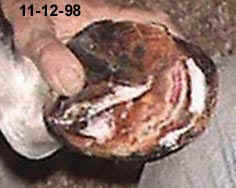
Al would have made faster progress on this horse, and would not have needed to do as much nursing care, if he had been trimming more correctly. The heels were too high, and the sole in the back half of the foot, along with the bars, were not trimmed right. In spite of this, the horse still healed. I am not advocating trimming the sole in the toe area, but from the tip of the frog on back.
His nursing care included cleaning with peroxide, putting on an ointment of sugardine (Betadine and sugar mixed into a paste), and bandaging with disposable diapers and Vetwrap.
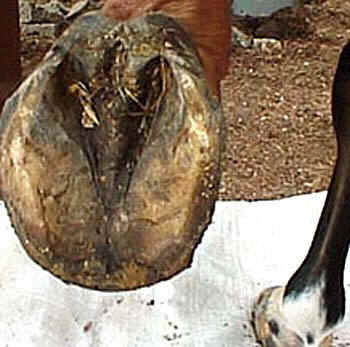
Not any indication that this was Juguete's worst foot...sole filled in solid.
(This foot is still contracted and could use opening cuts.)
(Photo, courtesy Al Catalfumo)
| From: Black Durgon Inn & Properties bkdurgon@bonairelive.net To: Gretchen Fathauer <gretchenfathauer@ee.net> Date: Tuesday, July 27, 1999 9:01 PM Subject: Re: another Juguete photo on my page Juguete is doing great. He made me a very happy man. He has put all the donkeys back in their places, his ears are up, his attitude is great, and he’s back to his normal weight. This barefoot stuff really works. Don't hesitate to send any disbelievers my way. The luckiest day of my live was when I decided against the heartbars. Was not sure why at the time--I had no idea what was right or wrong. I gathered all the information that I could, but it was just a gut feeling. I think common sense told me that all those nails could not help a thing. I was able, through access to his bare foot, to keep them trimmed for constant support on the frog. You remember what happened to his front feet when I left the digit support shoes on too long [8 weeks]. My Juguete had all the problems that could come from founder. Yes, it takes time, but I watched him cure steadily each day. The vet who took the first x-rays, and all the other vets, gave me doomsday stories, but now they have a different outlook. (0% of them had ever taken a horse this far gone, so how the hell do they know?) For example, Juguete’s coronary bands separated 3/4 of the way around--pink proud flesh. I watched them close up from the sides daily for weeks. It now has hoof growing. I was almost quitting at that stage because I did not know what I know now.
(Showing just how bad things were when Al was close to giving up hope. Coronet band separation is common after abscesses have come out through the coronet band, although this is extreme.) I could not live with the idea of putting my guy to sleep without giving him a chance, though, and I now am extremely happy. --Al |
Al has a point about the nails doing some damage. Dr. Strasser lists a number of bad effects of nails in the feet….conducting cold into the interior of the foot, allowing bacteria and ammonia a pathway into the white line, and limiting circulation because they fixate the foot to a rigid shoe so it cannot expand as much on each step. Here is a photo from the Strasser class of a cadaver foot, showing nail damage. This photo was taken after the foot had been de-shod and trimmed in the class. Damage includes:
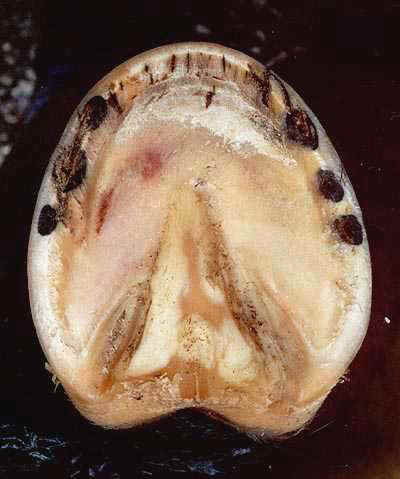
Bruising and rot from and around nails due to fixation of the hoof by shoe and nails.
White line separation at the toe due to improper trim—high heels, long toe—and possible rotation.
Bruising on inside of sole due to improper trim/lateral balance—inside of hoof was left higher than the outside.
Bruising from fixation of hoof by shoe—sole not being able to draw flat with each step caused bruising from coffin bone.
Sole Penetration is much more likely when you have high, folded over bars creating heel pain; the horse then starts "toe-walking," which is putting as much weight on the toes as possible to avoid heel pain. This heel pain is the result of the softer sole and sole corium being crushed between the coffin bone and the hard bar horn. This makes rotation more likely because the coffin bone is tipped down more in the front, overloading the toe laminae. The delicate sole corium (blood supply) is pinched so much between the sharp, hard coffin bone tip and the ground that sole cannot be grown as fast as it is worn away, eventually leading to sole penetration.
The pain from the coffin bone tip pushing through the toe area of the sole is considerable, too, but is less than heel pain. A horse can get a little less toe pain by standing on softer ground; the sole is then being squeezed between the hard, sharp tip of the coffin bone and the softer ground. In the case of overgrown bars, which are quite hard, the horse cannot escape heel pain on softer ground. His weight will squeeze the sole and sole corium between a hard, sharp-edged coffin bone and hard, unyielding bar tissue, no matter how soft the terrain he is on. Getting the coffin bone bottoms ground-parallel, and removing hard, overlaid bar horn, will undo this situation. Below is an extreme example:
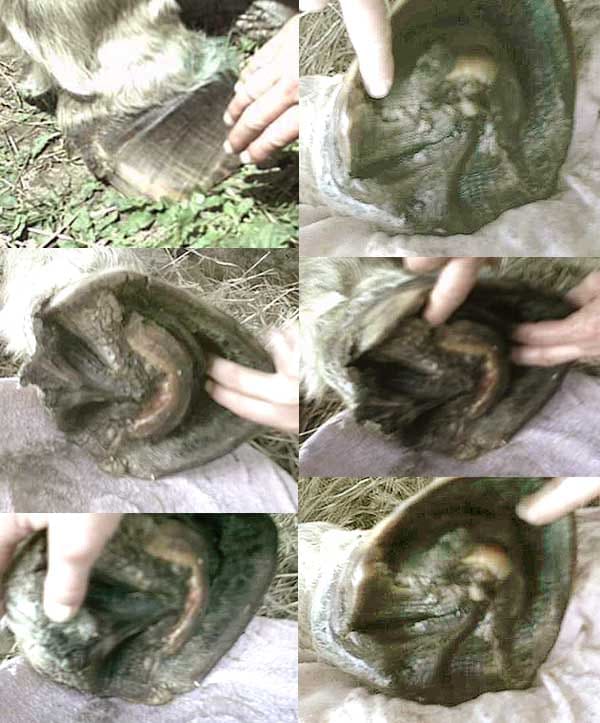
There is exposed coffin bone here. There is so much detachment of the toe wall that you can slide your fingers up under it. The wrinkle in the toe wall near the top, in an "S" shape, is formed by the loose toe wall folding over on itself. There may be a little bit of sound attachment under this, but no more than 1/2". This whole problem started with heel pain and a trim that did not result in a ground-parallel coffin bone bottom. The tilted coffin bone from high heels made rotation more likely. Note enormously overgrown bars.
The solution for this horse is to remove detached wall, lower the heels, and drastically reduce the bars. The frog may also need lowering once the heels and bars are correct. The "S"-shaped section of folded over wall just under the coronet band also needs to come off, as it is acting like a tight band, compressing blood supply to the foot. Once all this comes off, there won't be much left! However, this will enable stronger new growth to come down.
For a case of sole penetration that CSHS Rachael Coggins is working on in Texas, an Arabian stallion named Winnie who was not responding well to orthopedic shoeing, but who healed from sole penetration using barefoot methods, Click HERE
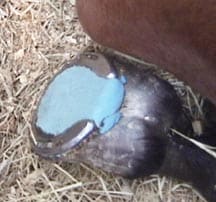
Winnie--Feb. 2001 orthopedic shoeing
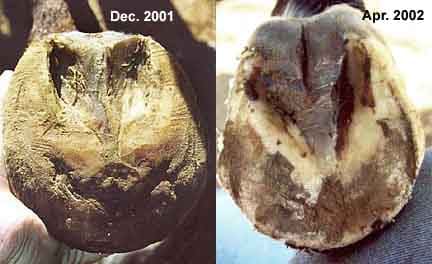
Winnie--sole penetration healing
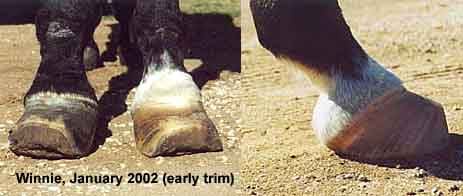
An early trim (Jan. 2002)
Contact Rachael Coggins CSHS, Winnie's trimmer, at 830-374-5313, or Email Rachael
Contact Lori Savage, Winnie's owner, at 830-216-7793, or Email Lori
For another case involving sole penetration on all fours, go to Section 22
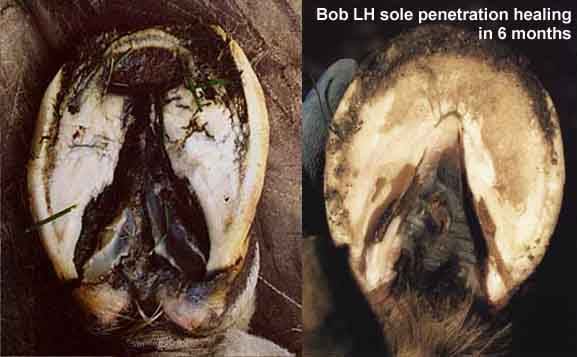
Bob, sole penetration healing in 6 months
To see more hoof cross-sections or to order specimens--
The Horse Science Co., has a fabulous image catalog for $10, showing all the color specimen slides they sell for $5 each. There are 50 images on laminitis alone, from moderate to incredibly severe. They also sell freeze-dried hooves that have been cleaned and varnished, and cut down the middle. Many variations of hinging and sectioning available on specimens. There are several hundred images of other leg and foot abnormalities and injuries, teeth, and soft tissue injuries. A must for your library! Contact Allie Hays at:
Horse Science ? Horse Sense (Anatomy Studies and Hoof Models)
PO Box 221
West Boxford, Massachusetts 01885
(978) 352-6336 (FAX: 5238)
http://horsescience.com has photos of a number of specimens.
Many of the "healthy" specimens will be deformed by Dr. Strasser's standards, however.
Back to home page--Table of Contents
Article in sections with "thumbnail" photos for fastest downloads:
1 9 17
2 10 18
3 11 19
4 12 20
5 13 21
6 14 22
7 15 23
8 16 24
NAVICULAR
Article in sections with full-sized photos for print-outs:
1 9 17
2 10 18
3 11 19
4 12 20
5 13 21
6 14 22
7 15 23
8 16 24
NAVICULAR
To Strasser case studies--thumbnail photos for faster downloads
To Strasser case studies--large photos
Please sign my guest book! Photos of my pets My farm
Share Barefoot success stories on this page
Buy or sell used HORSE BOOTS Natural board Barn Listings
Click here to subscribe to naturalhorsetrim
(I moderate this listserv to weed out "fluff.")
Send Email to Gretchen Fathauer, or call (740) 674-4492
Copyright by Gretchen Fathauer, 2015. All rights reserved.